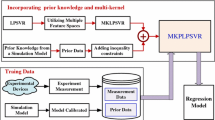Abstract
In this paper, we introduce a new method, support vector regression (SVR) method, to model millimeter wave transitions. SVR is based on the structural risk minimization (SRM) principle, which leads to good generalization ability for regression problem. The SVR model can be electromagnetically developed with a set of training data and testing data which produced by the electromagnetic simulation. Two Ka-band millimeter wave transitions, i.e., waveguide to microstrip transition and coaxial to waveguide adapter, are used as examples to validate the method. Experimental results show that the developed SVR models have a good predictive ability, and they are useful for interactive CAD of millimeter wave transitions.






Similar content being viewed by others
References
B. Wang, Artifical neural network models for coaxial to waveguide adapters. Int. J. Infrared Millim. Waves. 20(1), 125–136 (1999)
Y. Shih, T. Ton, and L. Bui, Waveguide-to-microstrip transitions for millimetre-wave applications. IEEE MTT-S Int. Microw. Symp. Dig. 1, 473–475 (1988)
B.Wang, and S. Zou, Artifical neural network models for the double-vias in multilayer stripline circuits. Int. J. Infrared Millim. Waves. 19(7), 1377–1386 (1999)
P. M. Waston, and K. C. Gupta, EM-ANN models for microstrip vias and interconnects in dataset circuits. IEEE Trans. Microw Theory Tech. 44, 2495–2503 (1996)
Y. Lee, and D. S. Filipovic, ANN based electromagnetic models for the design of RF MEMS switches. IEEE Microw. Wirel. Compon. Lett. 15(11), 823–825 (2005)
K. Chen, C. Ho, and H. Shiau, Application of support vector regression in forecasting international tourism demand. Tour. Manag. Res. 4, 81–97 (2004)
V. N. Vapnik, The Nature of Statistical Learning Theory. (Springer-Verlag, New York, 1995).
V. N. Vapnik, Statistical Learning Theory. (Wiley, New York, 1998).
A. Farag, and R. M. Mohamed, Regression using Support Vector Machines: Basic Foundations. Technical Report, University of Louisville, 12 (2004).
W. Chu, C. J. Ong, and S. S. Keerthi, An improved conjugate gradient scheme to the solution of least squares SVM. IEEE Trans. Neural Netw. 6, 498–501 (2005)
C.-W. Hsu, C.-C. Chang, and C.-J. Lin, A practical guide to support vector classification. Technical Report, National Taiwan University (2003).
C. C. Chang, and C. J. Lin, LIBSVM, A library for support vector machines and some documents, Available: http://www.csie.ntu.edu.tw/~cjlin/libsvm (2006).
J. Platt, Fast Training of Support Vector Machines Using Sequential Minimal Optimization. Advances in Kernel Methods Book. (MIT Press, Cambridge MA, 1999), pp. 185–208.
R. Scheaffer, and J. Mcclave, Statistics for Engineers. (Duxbury Press, Boston, MA 1982).
Author information
Authors and Affiliations
Corresponding author
Rights and permissions
About this article
Cite this article
Meng, J., Xia, L. Support Vector Regression Model for Millimeter Wave Transitions. Int J Infrared Milli Waves 28, 413–421 (2007). https://doi.org/10.1007/s10762-007-9212-1
Received:
Accepted:
Published:
Issue Date:
DOI: https://doi.org/10.1007/s10762-007-9212-1




